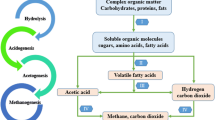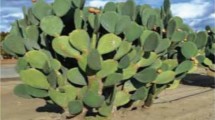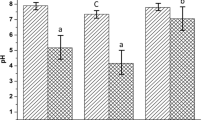Abstract
The performance of dry anaerobic digestions of cow dung, pig manure, and their mixtures into different ratios were evaluated at 35 ± 1 °C in single-stage batch reactors for 63 days. The specific methane yields were 0.33, 0.37, 0.40, 0.38, 0.36, and 0.35 LCH4/gVSr for cow dung to pig manure ratios of 1:0, 4:1, 3:2, 2:3, 1:4, and 0:1, respectively, while volatile solid (VS) and chemical oxygen demand (COD) removal efficiencies were 48.59, 50.79, 53.20, 47.73, 46.10, and 44.88 % and 55.44, 57.96, 60.32, 56.96, 53.32, and 50.86 %, respectively. The experimental results demonstrated that the co-digestions resulted in 5.10–18.01 % higher methane yields, 2.03–12.95 % greater VS removals, 2.98–12.52 % greater COD degradation and so had positive synergism. The various mixtures of pig manure with cow dung might persuade a better nutrient balance and dilution of high ammonia concentration in pig manure and therefore enhanced digester performance efficiency and higher biogas yields. The dry co-digestion of 60 % cow dung and 40 % pig manure achieved the highest methane yield and the greatest organic materials removal efficiency than other mixtures and controls.







Similar content being viewed by others
References
Demirer, G. N., & Othman, M. (2007). Two-phase thermophilic acidification and mesophilic methanogenesis anaerobic digestion of waste-activated sludge. Environmental Engineering Science, 25(9), 1291–1300.
Lema, J. M., & Omil, F. (2001). Anaerobic treatment: a key technology for a sustainable management of wastes in Europe. Water Science and Technology, 44, 133–140.
Oliveira, L. B., & Rosa, L. P. (2003). Brazilian waste potential: energy, environmental, social and economic benefits. Energy Policy, 31, 1481–1491.
Walker, L., Charles, W., & Cord-Ruwisch, R. (2009). Comparison of static, in-vessel composting of MSW with thermophilic anaerobic digestion and combinations of the two processes. Bioresource Technology, 100(16), 3799–3807.
Lou, X. F., & Nair, J. (2009). The impact of landfilling and composting on greenhouse gas emissions—a review. Bioresource Technology, 100(16), 3792–3798.
Veeken, A., Kalyuzhnyi, S., Scharff, H., & Hamelers, B. (2000). Effect of pH and VFA on hydrolysis of organic solid waste. Journal of Environmental Engineering – ASCE, 126, 1076–1081.
De Baere, L. (2000). Anaerobic digestion of solid waste: state-of-the-art. Water Science and Technology, 41(3), 283–290.
Jha, A. K., Li, J., Nies, L., & Zhang, L. (2011). Research advances in dry anaerobic digestion process of solid organic wastes. African Journal of Biotechnology, 10(65), 14242–14253.
Pavan, P., Battistoni, P., Mata-Alvarez, J., & Cecchi, F. (2000). Performance of thermophilic semi-dry anaerobic digestion process changing the feed biodegradability. Water Science and Technology, 41(3), 75–81.
Liu, G. T., Peng, X. Y., & Long, T. R. (2006). Advance in high-solid anaerobic digestion of organic fraction of municipal solid waste. Journal of Central South University of Technology, 13, 151–157.
Li, D., Yuan, Z., & Sun, Y. (2010). Semi-dry mesophilic anaerobic digestion of water sorted organic fraction of municipal solid waste (WS-OFMSW). Bioresource Technology, 101, 2722–2728.
Jha, A. K., He, J., Li, J. & Zheng, G. (2010). Effect of substrate concentration on methane fermentation of cattle dung. Proceedings of the International Conference on Challenges in Environmental Science and Computer Engineering. Wuhan, P. R. China. March 6–7, pp. 512–515.
Fongsatitkul, P., Elefsiniotis, P., & Wareham, D. G. (2010). Effect of mixture ratio, solids concentration and hydraulic retention time on the anaerobic digestion of the organic fraction of municipal solid waste. Waste Management Research, 28, 811–817.
Zinder, S. H. (1993). Physiological ecology of methanogens. In J. G. Ferry (Ed.), Methanogenesis: ecology, physiology, biochemistry and genetic (pp. 128–206). New York: Chapman & Hall.
Guendouz, J., Buffière, P., Cacho, J., Carrère, M., & Delgenes, J. P. (2010). Dry anaerobic digestion in batch mode: design and operation of a laboratory-scale, completely mixed reactor. Waste Management, 30, 1768–1771.
De Baere, L. (2006). Will anaerobic digestion of solid waste survive in the future? Water Science Technology, 53(8), 187–194.
Li, X., Li, L., Zheng, M., Fu, G., & Lar, J. S. (2009). Anaerobic co-digestion of cattle manure with corn stover pretreated by sodium hydroxide for efficient biogas production. Energy and Fuels, 23, 4635–4639.
Li, J., Jha, A. K., He, J., Ban, Q., Chang, S., & Wang, P. (2011). Assessment of the effects of dry anaerobic co-digestion of cow dung with waste water sludge on biogas yield and biodegradability. International Journal of Physical Science, 6(15), 3679–3688.
Naomichi, N., & Yutaka, N. (2007). Recent development of anaerobic digestion processes for energy recovery from wastes. Journal of Bioscience and Bioengineering, 103(2), 105–112.
VanVelsen, A. F. M. (1979). Adaption of methanogenic sludge to high ammonia-nitrogen concentrations. Water Research, 13, 995–999.
Webb, A. R., & Freda, R. (1985). The anaerobic digestion of poultry manure: variation of gas yield with influent concentration and ammonium-nitrogen levels. Agricultural Wastes, 14(2), 135–156.
Gacho, C. C., Flavier, M. E., Alfafara, C. G., Briones, N. D., Alcantara, A. J., Rodriguez, E. B., & Silverio, C. M. (2010). Anaerobic filter bed baffled reactor (AFBBR) for the treatment of food-processing wastewater. Journal of Environment Science Management, 13(1), 12–26.
APHA. (1995). Standard methods for the examination of water and wastewater [J] (19th ed.). Washington: American Public Health Association.
Østergaard, N. (1985). Biogasproduktion i det thermofile temperaturinterval. STUB rapport nr. 21. Kemiteknik. Taastrup: Dansk Teknologisk Institut (in Danish).
Bassam, B. J., Caetano-Anollés, G., & Gresshoff, P. M. (1991). Fast and sensitive silver staining of DNA in polyacrylamide gels. Analytical Biochemistry, 196, 80–83.
Hansen, K. H., Angelidaki, I., & Ahring, B. K. (1998). Anaerobic digestion of swine manure: inhibition by ammonia. Water Research, 32, 5–12.
Angelidaki, I., & Ahring, B. (1993). Thermophilic anaerobic digestion of livestock waste: the effect of ammonia. Applied Microbiology and Biotechnology, 38, 560–564.
De Baere, L. A., Devocht, M., vanAssche, P., & Verstraete, W. (1984). Influence of high NaCl and NH4Cl salt levels on methanogenic associations. Water Research, 18(5), 543–548.
Montero, B., Garcia-Morales, J. L., Sales, D., & Solera, R. (2008). Evolution of microorganisms in thermophilic-dry anaerobic digestion. Bioresource Technology, 99(8), 3233–3243.
Zhao, H. W., & Viraraghavan, T. (2004). Analysis of the performance of an anaerobic digestion system at the Rigna Wastewater Treatment Plant. Bioresource Technology, 95(3), 301–307.
Hobson, P. N., Bousfield, S. & Summers, R. (1981). Methane production from agricultural and domestic. Waste. Appl. Sci. publication, London, pp. 269
Yeole, T. Y., & Ranande, D. R. (1992). Alternative feedstock for biogas. Tropical Animal Production, 9(3), 10–16.
Bhattacharya, T. K., & Mishra, T. N. (2005). Biodegradability of dairy cattle manure under dry anaerobic fermentation process. Journal of Institute of Engineers (India): Agricultural Engineering Division, 84, 9–11.
Luning, L., VanZundert, E. H., & Brinkmann, A. J. (2003). Comparison of dry and wet digestion for solid waste. Water Science and Technology, 48(4), 15–20.
Mata-Alvarez, J., Mace, S., & Labres, P. (2000). Anaerobic digestion of organic solid wastes: an overview of research achievements and perspectives. Bioresource Technology, 74(1), 3–16.
Acknowledgments
The authors gratefully acknowledge the National Natural Science Foundation of China (Grant No. 51178136) and the State Key Laboratory of Urban Water Resource and Environment, Harbin Institute of Technology (Grant No. HCK201206) for valuable financial support.
Author information
Authors and Affiliations
Corresponding author
Rights and permissions
About this article
Cite this article
Li, J., Jha, A.K. & Bajracharya, T.R. Dry Anaerobic Co-digestion of Cow Dung with Pig Manure for Methane Production. Appl Biochem Biotechnol 173, 1537–1552 (2014). https://doi.org/10.1007/s12010-014-0941-z
Received:
Accepted:
Published:
Issue Date:
DOI: https://doi.org/10.1007/s12010-014-0941-z




